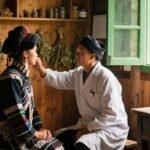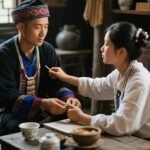Gangb Xint Bu ( Vitiligo)
Overview
In Miao-medicine, vitiligo is called Gangb Xint Bu (also known as Gang Jiang Shu). It manifests as white patches on the face, trunk, and limbs. In TCM, vitiligo presents as acquired, localized loss of skin pigment with irregularly shaped white macules. Western medicine recognizes vitiligo as a chronic depigmentation disorder characterized by well‑defined white or milk‑white spots or plaques that gradually enlarge; hair in the affected areas may turn white.
Miao-Medicine Classification
Vitiligo is classified as a minor disorder.
Etiology
Triggered by invasion of wind‑borne or heat‑borne toxins into the skin. Internally, irregular diet can lead to excess wind and heat toxins accumulating with dampness, injuring the vessels and blood. Externally, invasion of wind‑heat toxins leads to qi and blood stagnation, causing pigment loss.
Pathogenesis
Wind and heat toxins injury the skin, stirring blood heat that joins with wind toxins. Skin lesions first turn red or white, then spread to multiple areas.

Diagnostic Criteria
Clinical Signs
White patches of varying sizes and shapes that often merge into larger areas
Sharp borders with surrounding hyperpigmentation
Lesions may appear symmetrically or follow nerve segments
Hair in the depigmented areas may also whiten
Skin Pathology
Biopsy shows absence of melanocytes and melanin granules in the epidermis.
Differential Diagnosis
Gasha (Boil)
Boils begin as painful red nodules that swell, become hot, and may ulcerate with fever. Vitiligo patches are asymptomatic, non‑tender, and non‑inflammatory.
Pattern Differentiation & Treatment
Cold‑Channel Vitiligo
Presentation: Slow‑growing, non‑itchy white patches; skin may thicken and scale; margins remain distinct.
Pattern: Cold in the channels leading to pigment loss.
Principle: Dispel wind‑heat, invigorate blood, moisturize skin.
Herbal Formula (decoct and wash the lesions):
Portulaca oleracea (ma chi xian) 30 g
Artemisia capillaris (guo lu hui) 20 g
Clematis chinensis (shen jin cao) 20 g
ma chi xian clears heat, detoxifies, and cools blood; guo lu hui clears heat, breaks up stasis, promotes urination; shen jin cao warms the channels, invigorates blood, dispels wind.
Preventive Care
Sun Exposure
Moderate solar therapy is beneficial but avoid over‑exposure. Protect unaffected skin with sunscreen or clothing.
Topical Caution
Do not overuse irritating medicines or harsh topicals that may damage the skin barrier.
Commentary
Vitiligo in Miao medicine is seen as the result of internal wind‑heat toxins or external wind‑heat invasion, leading to qi and blood stagnation and pigment loss. Treatment emphasizes dispersing wind‑heat, activating blood flow, and nourishing the skin—often using heat‑clearing herbs such as ma chi xian to cool the blood and support repigmentation.



Leave a Reply